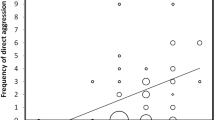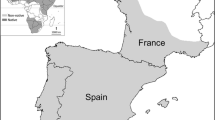Abstract
Two groups of litters obtained from individuals captured in natural environments have been monitored under laboratory conditions. The females of one group reared the offspring in the absence of sires; the litters of the other group are raised by both parents. It is ascertained that the presence of sires, especially those who are characterized by higher levels of aggression, has a negative effect on the survival and growth rates of the pups. Therefore, the reproductive success of common vole males can decrease if they enter the family-group composition and depends on the specificity of their behavior, first and foremost, an inclination toward exhibiting aggression.
Similar content being viewed by others
References
Ahroon, J.K. and Fidura, F.G., The influence of the male on maternal behavior in the Mongolian gerbil (Meriones unguiculatus), Anim. Behav., 1976, vol. 24, pp. 372–375.
Bashenina, N.V., Ekologiya obyknovennoi polevki i nekotorye cherty ee geograficheskoi izmenchivosti (Ecology of the Common Vole and Some Features of Geographical Variability), Moscow: Mosk. Gos. Univ., 1962.
Bashenina, N.V. and Meier, M.N. Postnatal growth, in Obyknovennaya polevka: vidy dvoiniki Microtus arvalis Pallas, 1779 i M. rossiaemeridionalis Ognev, 1924 (The Common Vole: Sibling Species Microtus arvalis Pallas, 1779 and M. rossiaemeridionalis Ognev, 1924), Moscow: Nauka, 1994, pp. 242–245.
Bashenina, N.V., Meier, M.N., and Zorenko, T.A., Ontogenesis, in Obyknovennaya polevka: vidy dvoiniki Microtus arvalis Pallas, 1779 i M. rossiaemeridionalis Ognev, 1924 (The Common Vole: Sibling Species Microtus arvalis Pallas, 1779 and M. rossiaemeridionalis Ognev, 1924), Moscow: Nauka, 1994, pp. 253–266.
Blumstein, D.T. and Armitage, K.B., Life history consequences of social complexity: a comparative study of ground-dwelling sciurids, Behav. Ecol., 1998, vol. 9, pp. 8–19.
De Jonge, G., Aggression and group formation in the voles Microtus agrestis,M. arvalis, and Clethrionomys glareolus in relation to intra- and interspecific competition, Behaviour, 1983, vol. 84, pp. 1–73.
Dudley, D., Contributions of parental care to the growth and development of the young Peromyscus californicus, Behav. Biol., 1974, vol. 11, pp. 155–156.
Eisenberg, J.F., The social organization of mammals, Handb. Zool., 1965, vol. 8, pp. 1–191.
Elwood, R.W. and Broom, D.M., The influence of litter size and parental behavior on the development of Mongolian gerbil pups, Anim. Behav., 1978, vol. 26, pp. 438–454.
Emlen, S.T., Benefits, constraints and the evolution of the family, Trends Ecol. Evol., 1994, vol. 9, pp. 282–284.
Gerling, S. and Yahr, P., Effect of the male parent on pup survival in Mongolian gerbils, Anim. Behav., 1979, vol. 27, pp. 310–311.
Gromov, V.S., Zabota o potomstve u gryzunov: etologicheskie, fiziologicheskie i evolyutsionnye aspekty (Parental Care in Rodents: Ethological, Physiological, and Evolutionary Aspects), Moscow: KMK, 2013a.
Gromov, V.S., Care of young and the effect of the presence of a male on parental behavior of the common vole (Microtus arvalis) in captivity, Contemp. Probl. Ecol., 2013b, vol. 6, no. 3, pp. 330–335.
Gromov, V.S., Complicated social structure and the evolution of sociality in rodents: cooperation as the main promoting factor, in Social Behavior: Evolutionary Pathways, Environmental Influences and Impairments, Watson, P., Ed., New York: Nova Sci., 2014, pp. 71–119.
Gromov, V.S., Krasnov, B.R., and Shenbrot, G.I., Behavioural correlates of spatial distribution in Wagner’s gerbil Gerbillus dasyurus (Rodentia, Gerbillinae), Mammalia, 2001, vol. 65, pp. 111–120.
Gromov, V.S. and Voznesenskaya, V.V., Care of young, aggressiveness, and secretion of testosterone in male rodents: a correlation analysis, Biol. Bull., 2013, vol. 40, no. 5, pp. 463–470.
Gubernick, D.J., Wright, S.L., and Brown, R.E., The significance of father’s presence for offspring survival in the monogamous California mouse, Peromyscus californicus, Anim. Behav., 1993, vol. 46, pp. 539–546.
Hartung, T.G. and Dewsbury, D.A., Paternal behavior of six species of muroid rodents, Behav. Neural Biol., 1979, vol. 26, pp. 446–478.
Hoogland, J.L., The Black-Tailed Prairie Dog: Social Life of a Burrowing Mammal, Chicago: Chicago Univ. Press, 1995.
Innes, D.G.L., A reexamination of litter size in some North American microtines, Can. J. Zool., 1978, vol. 56, pp. 1488–1496.
Kleiman, D.G., Monogamy in mammals, Quart. Rev. Biol., 1977, vol. 52, pp. 39–69.
Lacey, E.A., Sociality reduces individual direct fitness in a communally breeding rodent, the colonial tuco-tuco (Ctenomys sociabilis), Behav. Ecol. Sociobiol., 2004, vol. 56, pp. 449–457.
McGuire, B. and Novak, M., A comparison of maternal behavior in the meadow vole (Mictotus pennsylvanicus), prairie vole (M. ochrogaster) and pine vole (M. pinetorum), Anim. Behav., 1984, vol. 32, pp. 1132–1141.
Solomon, N.G., Current indirect fitness benefits associated with philopatry in juvenile prairie voles, Behav. Ecol. Sociobiol., 1991, vol. 29, pp. 277–282.
Solomon, N.G., Body size and social preferences of male and female prairie vole, Microtus ochrogaster, Anim. Behav., 1993, vol. 45, pp. 1031–1033.
Trivers, R.L., Parental investment and sexual selection, in Sexual Selection and Descent of Man, Campbell, B., Ed., Chicago: Aldine, 1972, pp. 139–179.
Werren, J.H., Gross, M.R., and Shine, R., Paternity and the evolution of male parental care, J. Theor. Biol., 1980, vol. 82, pp. 619–631.
Wittenberger, J.F. and Tilson, R.L., The evolution of monogamy: hypotheses and evidence, Annu. Rev. Ecol. Syst., 1980, vol. 11, pp. 197–232.
Wynne-Edwards, K.E. and Lisk, R.D., Differential effects of paternal presence on pup survival in two species of dwarf hamster (Phodopus sungorus and Phodopus campbelli), Physiol. Behav., 1989, vol. 45, pp. 465–469.
Zorenko, T.A., The population structure of the common vole Microtus arvalis Pall., in Dinamika populyatsii i povedenie pozvonochnykh zhivotnykh v Latviiskoi SSR (Dynamics of Population and Behavior of Vertebrates in Latvian SSR), Riga: Latv. Gos. Univ., 1979, pp. 79–101.
Author information
Authors and Affiliations
Corresponding author
Additional information
Original Russian Text © V.S. Gromov, 2016, published in Sibirskii Ekologicheskii Zhurnal, 2016, No. 6, pp. 911–918.
Rights and permissions
About this article
Cite this article
Gromov, V.S. Survival and growth rates of pups in common vole (Microtus arvalis) litters depending on the presence of sire. Contemp. Probl. Ecol. 9, 765–770 (2016). https://doi.org/10.1134/S1995425516060044
Received:
Accepted:
Published:
Issue Date:
DOI: https://doi.org/10.1134/S1995425516060044




